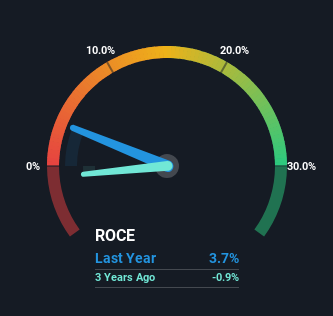Stock Analysis
Returns On Capital Signal Tricky Times Ahead For Plastiques du Val de Loire (EPA:PVL)

Finding a business that has the potential to grow substantially is not easy, but it is possible if we look at a few key financial metrics. Amongst other things, we'll want to see two things; firstly, a growing return on capital employed (ROCE) and secondly, an expansion in the company's amount of capital employed. If you see this, it typically means it's a company with a great business model and plenty of profitable reinvestment opportunities. However, after investigating Plastiques du Val de Loire (EPA:PVL), we don't think it's current trends fit the mold of a multi-bagger.
Return On Capital Employed (ROCE): What Is It?
Just to clarify if you're unsure, ROCE is a metric for evaluating how much pre-tax income (in percentage terms) a company earns on the capital invested in its business. The formula for this calculation on Plastiques du Val de Loire is:
Return on Capital Employed = Earnings Before Interest and Tax (EBIT) ÷ (Total Assets - Current Liabilities)
0.037 = €17m ÷ (€806m - €339m) (Based on the trailing twelve months to September 2023).
So, Plastiques du Val de Loire has an ROCE of 3.7%. Ultimately, that's a low return and it under-performs the Chemicals industry average of 4.7%.
See our latest analysis for Plastiques du Val de Loire

Above you can see how the current ROCE for Plastiques du Val de Loire compares to its prior returns on capital, but there's only so much you can tell from the past. If you're interested, you can view the analysts predictions in our free analyst report for Plastiques du Val de Loire .
So How Is Plastiques du Val de Loire's ROCE Trending?
On the surface, the trend of ROCE at Plastiques du Val de Loire doesn't inspire confidence. Over the last five years, returns on capital have decreased to 3.7% from 13% five years ago. However, given capital employed and revenue have both increased it appears that the business is currently pursuing growth, at the consequence of short term returns. And if the increased capital generates additional returns, the business, and thus shareholders, will benefit in the long run.
On a separate but related note, it's important to know that Plastiques du Val de Loire has a current liabilities to total assets ratio of 42%, which we'd consider pretty high. This effectively means that suppliers (or short-term creditors) are funding a large portion of the business, so just be aware that this can introduce some elements of risk. While it's not necessarily a bad thing, it can be beneficial if this ratio is lower.
The Key Takeaway
Even though returns on capital have fallen in the short term, we find it promising that revenue and capital employed have both increased for Plastiques du Val de Loire. These growth trends haven't led to growth returns though, since the stock has fallen 66% over the last five years. So we think it'd be worthwhile to look further into this stock given the trends look encouraging.
If you want to know some of the risks facing Plastiques du Val de Loire we've found 2 warning signs (1 is a bit concerning!) that you should be aware of before investing here.
While Plastiques du Val de Loire isn't earning the highest return, check out this free list of companies that are earning high returns on equity with solid balance sheets.
Valuation is complex, but we're helping make it simple.
Find out whether Plastiques du Val de Loire is potentially over or undervalued by checking out our comprehensive analysis, which includes fair value estimates, risks and warnings, dividends, insider transactions and financial health.
View the Free AnalysisHave feedback on this article? Concerned about the content? Get in touch with us directly. Alternatively, email editorial-team (at) simplywallst.com.
This article by Simply Wall St is general in nature. We provide commentary based on historical data and analyst forecasts only using an unbiased methodology and our articles are not intended to be financial advice. It does not constitute a recommendation to buy or sell any stock, and does not take account of your objectives, or your financial situation. We aim to bring you long-term focused analysis driven by fundamental data. Note that our analysis may not factor in the latest price-sensitive company announcements or qualitative material. Simply Wall St has no position in any stocks mentioned.
About ENXTPA:PVL
Plastiques du Val de Loire
Plastiques du Val de Loire manufactures and sells plastic parts in Europe and North America.
Very undervalued with moderate growth potential.

